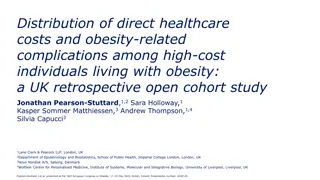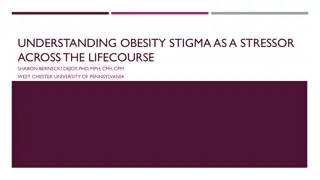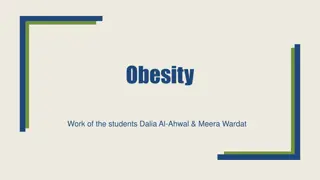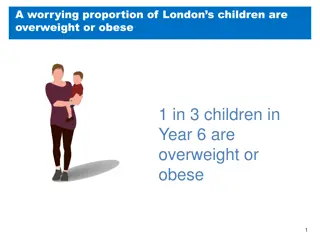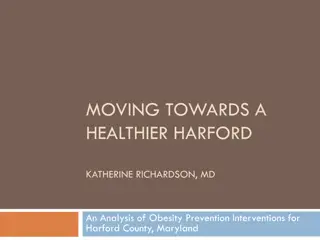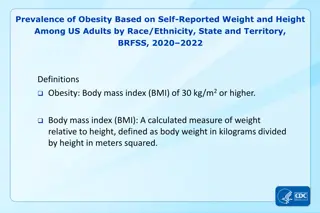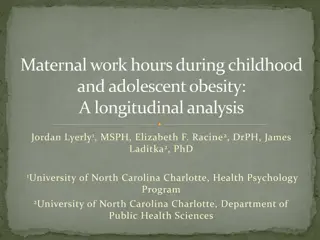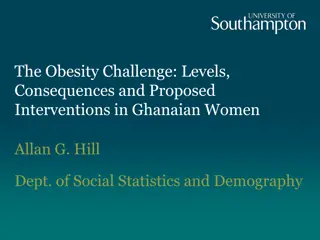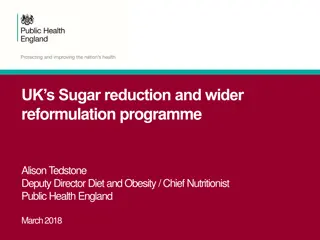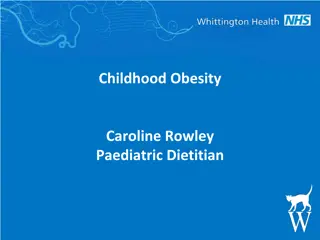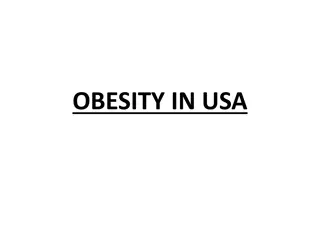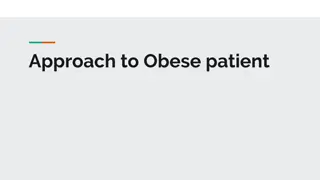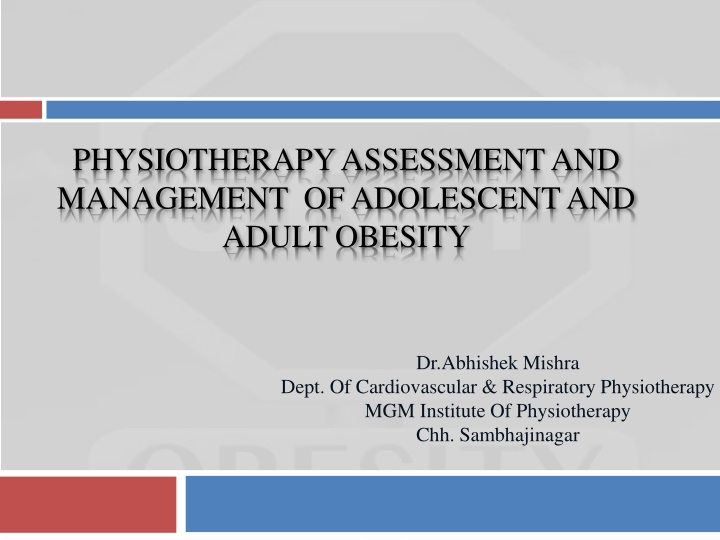
Physiotherapy Assessment and Management of Adolescent and Adult Obesity
Discover the assessment and management strategies for adolescent and adult obesity as outlined by Dr. Abhishek Mishra. Learn about the definition, prevalence, classification, etiology, and more related to overweight and obesity. Explore the various aspects including evaluation, exercise testing, and prescription in this comprehensive guide.
Download Presentation

Please find below an Image/Link to download the presentation.
The content on the website is provided AS IS for your information and personal use only. It may not be sold, licensed, or shared on other websites without obtaining consent from the author. If you encounter any issues during the download, it is possible that the publisher has removed the file from their server.
You are allowed to download the files provided on this website for personal or commercial use, subject to the condition that they are used lawfully. All files are the property of their respective owners.
The content on the website is provided AS IS for your information and personal use only. It may not be sold, licensed, or shared on other websites without obtaining consent from the author.
E N D
Presentation Transcript
PHYSIOTHERAPY ASSESSMENT AND MANAGEMENT OF ADOLESCENT AND ADULT OBESITY Dr.Abhishek Mishra Dept. Of Cardiovascular & Respiratory Physiotherapy MGM Institute Of Physiotherapy Chh. Sambhajinagar
Contents Definition Prevalence Classification Etiology Pathophysiology Complications Evaluation Exercise testing Exercise prescription
Definition Overweight and obesity are defined as abnormal or excessive fat accumulation that may impair health. The WHO definition is: - BMI greater than or equal to 25kg/m2is overweight - BMI greater than or equal to 30kg/m2is obesity.
Prevalence Adults : In 2014, more than 1.9 billion adults (39%), 18 years and older, were overweight. Of these over 600 million (13%) were obese. WHO, 2014 Adolescent : - Overweight - 34.5 percent of adolescents - Obese - 20.5 percent of adolescents - Severely obese - 11.4 percent of adolescent girls and 9.2 percent of adolescent boys
Classification Based on BMI: Category BMI (kg/m2) Underweight Normal Overweight Obesity class I Obesity class II Obesity class III < 18.5 18.5 24.9 25.0-29.9 30.0 34.9 35.0-39.9 > 40
BMI classification for Indian population Category Overweight US 25.0-29.9 kg/m2 INDIA 23-26.9kg/m2 Obese 30 kg/m2 27 kg/m2
Based on phenotype : Type I Excess body mass or percentage fat Type II Excess subcutaneous truncal abdominal fat (android) Type III Excess abdominal visceral fat Type IV Excess gluteal femoral fat (gynoid)
Based on cell morphology : - Hyperplastic obesity - Hypertrophic obesity Based on health status : - Mild obesity - Morbid obesity
Etiology Lifestyle Physical activity Sleep deprivation Cessation of smoking Dietary habits Eating problems Antipsychotic Antidepressants antiepileptic Diabetic drugs Diet Drug induced
Neuroendocrine obesity Hypothalamic obesity Cushing syndrome Hypothyroidism Growth hormones Psychologic factors Socioeconomic factors Factors in women Pregnancy Oral contraceptives Menopause PCOS
Pathophysiology Positive energy balance Role of hormones - leptin - gut peptides
Energy balance Low energy expenditure is one factor that can promote weight gain. Approximately 70 percent of energy expenditure is utilized for basal or resting metabolic processes including : the energy involved in maintaining body temperature and ion gradients across cell membranes cardiac and respiratory muscle function gastrointestinal motility and secretion metabolic storage and mobilization processes. Another 10 percent of energy expenditure is dissipated through the thermic responses to food. The final component of energy expenditure is activity and exercise.
Leptin Leptin hormone produced in fat cells, the placenta, and to a lesser degree in the gut. It signals the brain about the quantity of stored fat. With increasing adiposity, resistance to the action of leptin occurs, blunting the negative feedback "adipostatic" signal to brain centers to reduce energy intake. Obesity due to leptin deficiency has been found primarily in consanguineous families
Gut peptides The gastrointestinal peptide ghrelin - stimulates appetite. Other circulating mediators (eg, leptin, peptide YY, cholecystokinin, pancreatic polypeptide) inhibit intake.
Stimulators of food intake Neuropeptide Y is one of the most potent stimulators of food intake known. Ghrelin, melanin-concentrating hormone, growth hormone- releasing hormone, norepinephrine, and orexin-A and orexin- B (also called hypocretin) also stimulate food intake. The importance of melanocyte-stimulating hormone has been demonstrated by the observations that disruption of the melanocortin-4 receptor in the hypothalamus leads to massive obesity.
Inhibitors of food intake Cholecystokinin decreases food intake when administered either centrally or peripherally. Enterostatin reduces food intake, in particular fat intake, when given peripherally or into the brain. Infusion of the gut hormones GLP-1, pancreatic polypeptide, oxyntomodulin, or peptide YY 3-36 suppresses food intake in both lean and obese subjects.
Impact of satiety and hunger signals on body weight Inactivity + inefficient satiety signals Activity + efficient hunger signals Excess energy intake Adequate energy intake Controlled energy intake to achieve deficit Weight maintenance Weight loss Weight gain
Complications Cardiovascular - Stroke - Coronary heart disease - Hypertension Type 2 diabetes - Gallbladder disease - Gastro-oesophageal reflux disease - Hepatic, biliary and pancreatic disease - Cancers of the bowel, oesophagus (adenocarcinoma), gall bladder and pancreas - Obstructive sleep apnea -Asthma Endocrine Gastrointestinal Pulmonary
Musculoskeletal -Osteoarthritis -Spinal disc disorders - Lower back pain - Disorders of soft-tissue structures such as tendons, fascia and cartilage - Mobility disability - Impaired immune function - Chronic kidney disease - End-stage renal disease - Kidney cancer - Glomerulopathy - Kidney stones - Stress urinary incontinence (women) Genitourinary
Reproductive health - Menstrual disorders - Miscarriage and poor pregnancy outcome - Infertility - Breast cancer (postmenopausal women) - Endometrial cancer - Ovarian cancer Mental health - Depression -Anxiety disorder - Reduced health-related quality of life - Disordered eating
Informed consent Medical History Questionnaires Risk stratification Life style evaluation
Informed consent Purpose of test Inherent risk and precautions for minimizing risk Expected benefits Voluntary participation
Medical history Clients record of previous illness, surgeries or hospitalizations Previous medical diagnosis, signs/symptoms of diseases occurred in the past year or currently present Family history of DM, heart disease, stroke, hypertension
Questionnaires For identifying individuals who need medical clearance from physicians before starting an exercise program: PARQ + PAR Q & You PAR Q A AHA/ACSM Questionnaire For assessing physical activity : IPAQ : GPAQ
Risk factors Family history Cigarette smoking Hypertension SBP 140 mm Hg or DBP 90 mm Hg Dyslipidemia LDL>130mg.dl-1HDL<40 mg.dl-1 Impaired glucose level 100mg.dl-1 Obesity, sedentary lifestyle BMI.30 kg.m-2 High serum cholesterol level >60 mg.dl-1
Signs and symptoms Pain , discomfort for other anginal in the chest , neck, jaw, arms, or other areas that may result from ischemia Ankle oedema Shortness of breath at rest or with mild exertion Palpitations or tachycardia Dizziness or syncope Intermittent claudication Orthopnea or paroxysmal nocturnal dyspnea Known heart murmur, Unusual fatigue or shortness of breath with usual activities
Risk stratification Low risk Men <45 years of age and women <55 years of age who are asymptomatic and meet no more than one risk factor threshold Men 45years of age and women 55 years of age or those who meet the threshold for two or more factors Individuals with one or more sign and symptoms Moderate risk High risk
Lifestyle evaluation Information about smoking, lack of physical activity, diet high in saturated fats or cholesterol. These factors pinpoint to factors that need modification and assess likelihood of adherence to exercise program.
EVALUATION OF BODY COMPOSITION
Need for assessing body composition To classify your client s %BF and disease risk For estimating a healthy body weight and formulating nutrition recommendations and exercise prescriptions For estimating competitive body weight for athletes participating in sports that use body weight classifications for competition
For monitoring the growth of children and adolescents and identifying those at risk For assessing changes in body composition associated with aging, malnutrition, and certain diseases, as well as the effectiveness of nutrition and exercise interventions in counteracting these changes.
Methods Hydrostatic weighing Air displacement pleythsmography Dual energy X ray absorptiometry Skin fold Bio electrical impedance analysis BMI Waist hip ratio Waist circumference Sagittal abdominal diameter
Hydrostatic weighing Uses Archimedes principle weight loss under water is directly proportional to volume of water displaced by body volume Determined by totally submerging the body in an underwater weighing tank and measuring underwater weight (UWW) BV= [(BM-net UWW)/density of water] (RV+GV) BM= body mass RV= residual volume (helium dilution; N2 washout; O2 dilution) GV= vol. of air in GI tract (assumed 100 ml)
Air displacement pleythsmography It is a method that is used to measure body volume by air displacement instead of water displacement. Better as it is quicker, less compliance, minimal technician skill needed. Based on Boyle s Law Pressure and vol. are inversely related at constant temp. P1/P2 = V2/V1 Body vol. is calculated as difference in vol. of chamber with and without the client.
Dual energy X ray absorptiometry This method yields estimate of bone mineral, fat, lean soft tissue mass. The attenuation, or weakening of x-rays through fat, lean tissue, and bone varies due to difference in densities and chemical compositions of these tissues. Better: - Rapid and safe - Minimal client cooperation - Individual variability in bone mineral content
Skin fold Principle Amount of subcutaneous fat is proportional to the total amount of body fat. Assumptions - It is assumed that close to 1/3rd of the total fat is located subcutaneously - SKF is a good measure of subcutaneous fat - Distribution of fat subcutaneously and internally is similar for all individuals within each gender - Sum of several SKFs can be used to estimate total body fat - There is a relationship between sum of SKFs and body density - Age is an independent predictor of body density for both men and women
MEN - Three site formula (chest, abdomen & thigh) - Body density = 1.10938 - 0.0008267 (sum of 3 skinfolds) + 0.0000016 (sum of 3 skinfolds) - 0.0002574 (age) WOMEN - Three site formula (triceps, abdomen & supra-iliac) - Body density = 1.089733 0.0009245 (sum of 3 skinfolds) + 0.0000025 (sum of 3 skinfolds) - 0.0000979 (age)
Bio electrical impedance analysis A low level electrical current is passed through the body and the impedance to the flow of current is measured with BIA analyzer. Assumptions - Human body is shaped like perfect cylinder with uniform length and cross sectional area - Biological tissues act as conductors or insulators and the flow of current through the body will follow the path of least resistance.
Pre testing guidelines - No eating/drinking within 4 hrs of test - No exercise within 12 hrs of test - Void completely within 30 min of test - Do not ingest diuretics before assessment unless prescibed
BMI It is the ratio of body weight (kg) to height squared (m2). It is used to classify underweight, overweight and obese individuals. Relationship between BMI and % BF is affected by age, gender, ethnicity and body build. It is a better measure of subcutaneous fat than of visceral fat.
Waist hip ratio It is an indirect measure of upper and lower body fat distribution. WHR more than 0.94 for men and 0.82 for women are at high risk for adverse health consequences.
Limitations: - It is affected by post menopausal status - Not valid for evaluating fat distribution in pre- pubertal children - Accuracy in accessing visceral fat decreases with increasing fatness - Hip circumference is influenced only by subcutaneous fat deposition while waist circumference is influenced by both visceral as well as subcutaneous fat depositions
Waist circumference It is a very good predictor of obesity related health risk. Waist circumference of > 100 cm for men and > 95 cm for women leads to high risk of cardiovascular disease. Waist circumference cut off for indian population : > 90 for males > 85 for females Waist circumference cutoff and its importance for diagnosis of metabolic syndrome in Asian Indians: A preliminary study, 2012
Sagittal abdominal diameter It is a measure of anteroposterior thickness of abdomen at umbilical level. It is excellent indirect measure of visceral fat. Compared to waist circumference, BMI and WHR, SAD is more strongly related to risk factors for CVD and metabolic disease.
Cardiorespiratory endurance VO2 max VO2 peak Absolute VO2 Relative VO2 max Gross VO2
Guidelines for exercise testing The selection of a maximal or submaximal GXT depends on - your client s risk stratification (low risk, moderate risk, or high risk), - your reasons for administering the test (physical fitness testing or clinical testing), and - the availability of appropriate equipment and qualified personnel.
Procedure for exercise testing Read and sign informed consent form Complete PAR-Q Measure resting HR and BP Give 2-3 min of warm up Check HR,BP and RPE at regular intervals BP and RPE should be checked near the last minute of each stage Discontinue the test if termination criteria are reached Cool down should be given after test termination Recovery HR and BP should be checked


